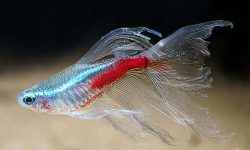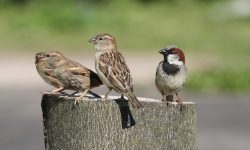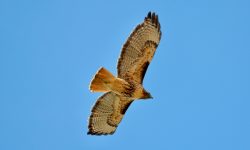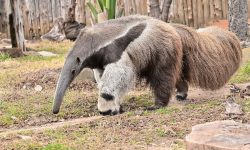Understanding the differences between crows and grackles can be surprisingly tricky for the untrained eye. Both birds are dark-colored, highly intelligent, and often found in urban and suburban environments. However, upon closer inspection, they are quite distinct in their appearance, behavior, and vocalizations.
This guide will provide an in-depth comparison of crows and grackles, covering physical traits, behavior, habitats, calls, and more—along with some fascinating facts you might not know.
What is a Crow?
Basic Characteristics of Crows
Crows belong to the genus Corvus, which includes species such as the American Crow (Corvus brachyrhynchos) and the Common Raven (Corvus corax). They are medium to large-sized birds known for their high intelligence, social behavior, and adaptability. Most crows measure between 16 and 21 inches in length and have a robust build.
Appearance
Crows have uniformly black feathers with a slight iridescent sheen under sunlight. They sport thick necks, heavy straight bills, and strong legs. Their eyes are dark, and they have broad wings with rounded tips. When flying, crows exhibit a smooth, methodical wingbeat and rarely glide.
Intelligence and Behavior
Crows are among the most intelligent birds on the planet. Studies have shown their ability to use tools, recognize human faces, and even hold grudges. They often live in complex social structures and communicate with a variety of vocalizations and body language.
What is a Grackle?
Basic Characteristics of Grackles
Grackles belong to the Icteridae family, which includes the Common Grackle (Quiscalus quiscula), Boat-tailed Grackle (Quiscalus major), and Great-tailed Grackle (Quiscalus mexicanus). They are considered songbirds, although their calls may not be melodious to human ears.
Appearance
Grackles are slightly smaller than crows, typically ranging from 11 to 13 inches in length. They have longer, keel-shaped tails and slender bodies. Unlike crows, grackles display striking iridescent plumage in blues, purples, and greens, especially visible in males. Their eyes are usually bright yellow or pale in color, creating a stark contrast against their dark feathers.
Behavior and Social Structure
Grackles are social birds that often form large flocks, particularly during migration. While not as famously intelligent as crows, they are clever and resourceful, often scavenging in urban settings. Males tend to be more dominant, and they often puff up their feathers and tails during mating displays.
Key Differences Between Crows and Grackles
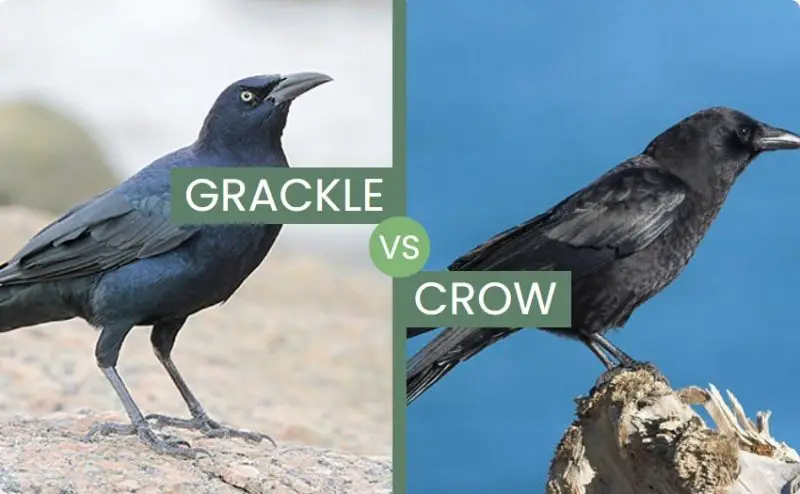
Size and Body Structure
One of the most immediately noticeable differences between crows and grackles lies in their size and body proportions. American crows typically measure about 17 to 21 inches in length and have a robust, heavyset build with broad wings and a thick neck. Their overall presence is more imposing, giving them a bulky, solid appearance. Grackles, especially the common grackle, are significantly smaller, usually ranging from 11 to 13 inches in length. They have a more streamlined physique, with a narrow body, longer legs, and an unmistakably long, keel-shaped tail that often appears V-shaped in flight.
Beak and Eye Color
Crows have stout, all-black beaks that are straight, strong, and slightly heavier-looking—designed for tearing and manipulating a wide range of food items. In contrast, grackles possess more slender, tapered beaks that can sometimes appear slightly down-curved, giving them a more delicate look. These beaks are well-suited for probing and foraging. Eye color is another reliable field mark: crows have uniformly dark eyes that range from deep brown to black, blending seamlessly with their plumage. Grackles, however, often stand out due to their pale yellow or glaring white irises, which create a stark contrast against their dark feathers and give them a somewhat intense, piercing gaze.
Plumage and Iridescence
While both birds appear dark at a glance, closer inspection—especially in good lighting—reveals a striking difference in their plumage. Crows are generally matte black with a very subtle sheen that may reflect faint hints of blue or purple in bright sunlight. Their feathers have a more uniform, velvety look. Grackles, on the other hand, are renowned for their glossy, iridescent feathers. Depending on the angle of light, their plumage can shimmer in shades of purple, blue, green, or bronze, particularly on the head and neck. This dazzling effect makes them visually distinct, especially when the two species are seen side by side.
Vocalizations
Crows are highly vocal birds with a broad repertoire of sounds. Their primary calls are loud, guttural “caws” that vary in pitch and rhythm, often used for communication within groups or to signal danger. Some crows are also capable of mimicking human speech and other environmental sounds. Grackles, in comparison, have a much more mechanical and less melodic vocal style. Their calls are a mix of sharp squeaks, high-pitched whistles, and harsh metallic-sounding notes that can resemble the squeal of a rusty hinge. These sounds are often described as strange, robotic, or even alien-like, setting them apart from the more familiar crow calls.
Flight Patterns
Flight behavior is another useful clue when distinguishing between these two birds. Crows have a powerful, steady flight with regular, deep wingbeats and minimal gliding. They appear deliberate and direct in the air, often flying in straight lines. Grackles exhibit a more flamboyant flight style. They tend to fly with an undulating rhythm, interspersing quick flaps with brief glides. Their long tails are usually flared outward and often slightly keel-shaped, giving them a distinctive silhouette in motion. This irregular and flashy flight pattern makes them stand out, especially in contrast to the more measured movements of crows.
Habitats and Range
Where You’ll Find Crows
Crows are found across most of North America, Europe, and Asia. They thrive in a wide variety of habitats, including forests, farmlands, and cities. Their adaptability allows them to live comfortably in both rural and urban areas.
Where You’ll Find Grackles
Grackles are most commonly found in the eastern and southern United States, with some species extending into Central America. They prefer open spaces like grasslands, wetlands, and suburban areas, often nesting in tall trees or shrubs near water sources.
Diet and Feeding Habits
What Crows Eat
Crows are omnivorous and have a highly varied diet. They eat insects, small mammals, fruits, seeds, carrion, and even garbage. Their problem-solving skills help them access difficult-to-reach food sources.
What Grackles Eat
Grackles also have an omnivorous diet but tend to eat more grains, seeds, insects, and small amphibians. They’re often seen foraging in parking lots and lawns, using their sharp beaks to pry open food items.
Nesting and Reproduction
Crow Nesting Habits
Crows build large nests high up in trees using sticks and twigs, lining them with softer materials like grass or feathers. Both males and females participate in nest building and raising the young. They typically lay 3–6 eggs per clutch.
Grackle Nesting Habits
Grackles usually nest in dense vegetation or tree canopies. Females build the nests, which are smaller and less elaborate than crow nests. They lay 4–7 eggs and may raise more than one brood per season.
Lifespan and Predators
How Long Do Crows Live?
In the wild, crows can live up to 7–8 years on average, but some individuals have been known to survive over 15 years. Their main predators include hawks, owls, and humans.
How Long Do Grackles Live?
Grackles generally have shorter lifespans, living around 5–7 years in the wild. They are preyed upon by cats, hawks, snakes, and raccoons.
Amazing Facts About Crows and Grackles
Amazing Crow Facts
- Crows can recognize individual human faces and remember them for years.
- They are known to use tools, such as sticks or wires, to extract food from tight spaces.
- Crows hold “funerals” for their dead, gathering around and vocalizing loudly.
Amazing Grackle Facts
- Male grackles puff up their feathers and sing loudly to attract females.
- Grackles can mimic the sounds of other birds and even mechanical noises.
- They have been observed dunking food in water to soften it before eating.
How to Tell Crows and Grackles Apart in the Field
Quick Identification Tips
- Size: Crows are larger and bulkier.
- Tail: Grackles have long, V-shaped tails.
- Color: Grackles show iridescent hues; crows are matte black.
- Eyes: Grackles often have yellow or white eyes; crows have dark eyes.
- Calls: Crows caw; grackles screech and whistle.
Best Places to Observe Them
Crows can be spotted almost anywhere, from city parks to open fields. Grackles are more likely to be seen in southeastern North America, especially around water bodies, parking lots, and grassy areas. Observing both during early morning or late afternoon offers the best lighting to catch iridescent plumage and behavioral patterns.
Why the Confusion Between Crows and Grackles?
The confusion arises due to their overlapping habitats and similar dark coloration. Both birds are noisy, urban-adapted, and comfortable around humans. To the casual observer, these similarities can make them hard to distinguish, especially from a distance or in poor lighting. However, once you learn their key differences, they become much easier to identify.
Conclusion: Crow vs Grackle – Who Wins the Identity Game?
While both birds are fascinating in their own right, understanding the unique characteristics of crows and grackles allows for better appreciation of each species. Crows win in terms of intelligence and complexity, whereas grackles stand out with their striking looks and vocal variety. Next time you spot a black bird in your neighborhood, use this guide to determine whether you’re looking at a clever crow or a glamorous grackle.
Whether you’re a birdwatching enthusiast, a casual observer, or just someone curious about nature, knowing the differences between these two black birds will enrich your experience and deepen your understanding of avian diversity.

